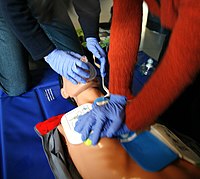
Photo from wikipedia
Isometric exercise training (IET) has been recognized for its association with lowering resting blood pressure in adults with and without hypertension. While IET has been shown to lower blood pressure… Click to show full abstract
Isometric exercise training (IET) has been recognized for its association with lowering resting blood pressure in adults with and without hypertension. While IET has been shown to lower blood pressure in many people, little is known about the effects of IET on blood pressure when performed by active cardiopulmonary rehabilitation patients. Purpose: Isometric handgrip (IHG) training lowers systolic and diastolic blood pressure (SBP and DBP, respectively), but the efficacy of IHG training in cardiopulmonary rehabilitation patients is unknown. The purpose of this study was to determine if IHG decreases blood pressure in cardiopulmonary rehabilitation patients. Methods: Cardiopulmonary rehabilitation program participants (n = 11; 50-80 yr old) were randomized to IHG (n = 6) or control (CON; no treatment; n = 5) groups. IHG participants completed an IHG training program at 30% maximal voluntary contraction, 3 d/wk for 6 wk. Resting SBP, DBP, and heart rate were assessed weekly. Results: Mean regression for SBP following IHG was negative (−1.04 ± 0.80). Mean regression in the CON group was positive (0.50 ± 0.88), but there was no significant difference between groups. Separate analysis of weeks 1 to 7 yielded a negative mean regression (−1.12 ± 0.54) in the IHG group, but positive (1.2 ± 0.60) in the CON group. A Wilcoxon test of these differences yielded significance for SBP (P = .009). In 3 of 6 IHG participants, SBP was lower (mean ± SD: −16 ± 11 mm Hg; P = .12), and in 2 IHG participants, DBP was lower (−9 ± 1 mm Hg; P = .06) compared with baseline. In 2 of 5 CON participants, SBP was not significantly lower (−11 ± 7 mm Hg) and, in 3 of 5 CON participants, DBP was lower (−7 ± 4 mm Hg; P = .04). Conclusions: Our data suggest that standard IHG training may be inadequate for blood pressure management immediately following a major cardiac or pulmonary event. Future work with a larger cohort and more developed training protocol to determine the efficacy of IHG training in patients with cardiopulmonary disease is warranted.
Journal Title: Journal of Cardiopulmonary Rehabilitation and Prevention
Year Published: 2019
Link to full text (if available)
Share on Social Media: Sign Up to like & get
recommendations!